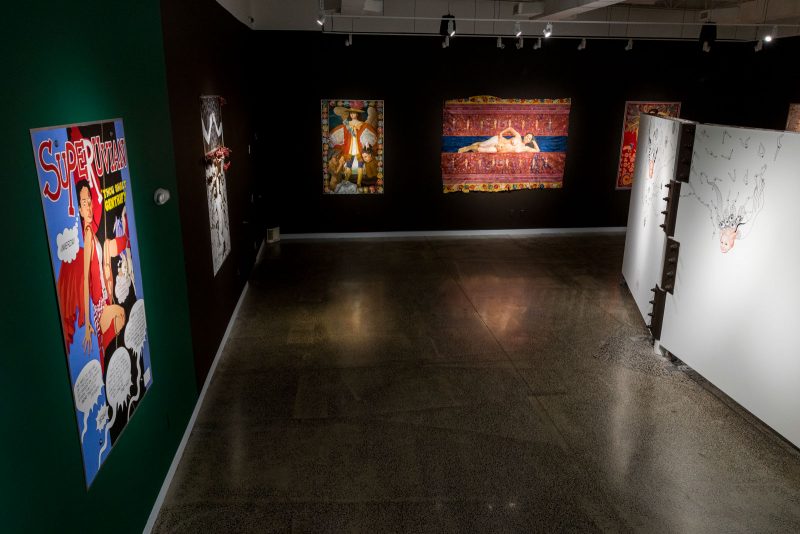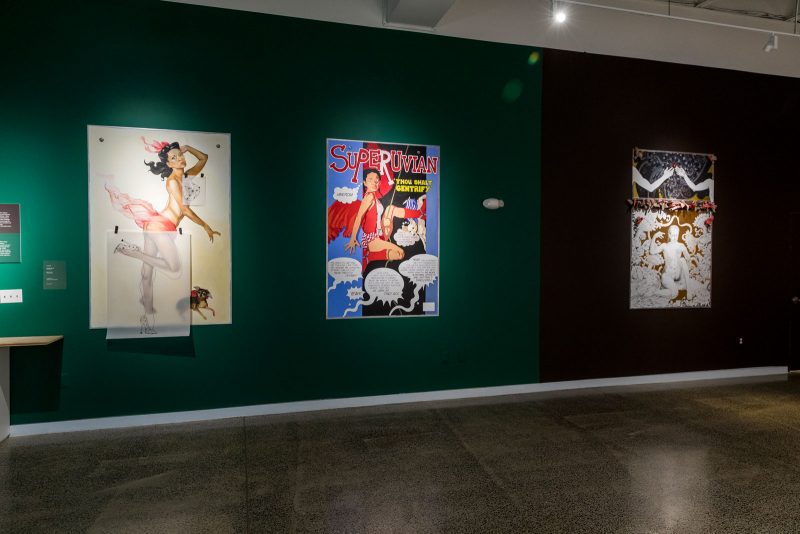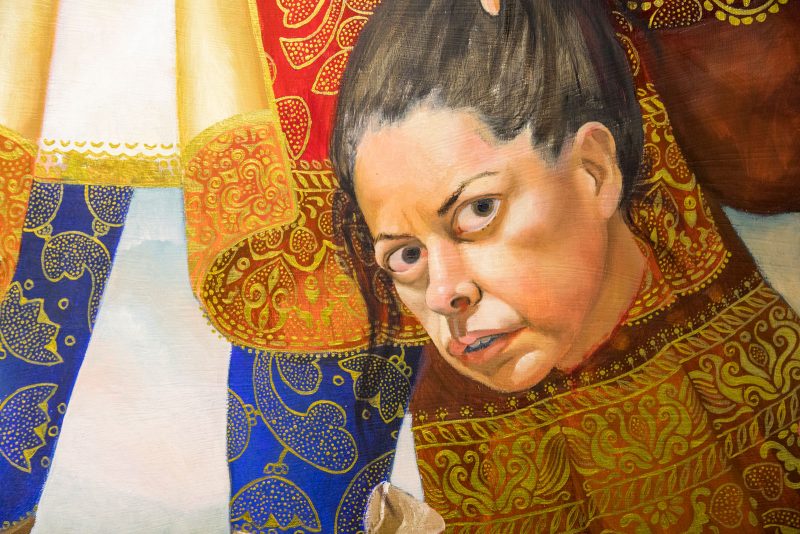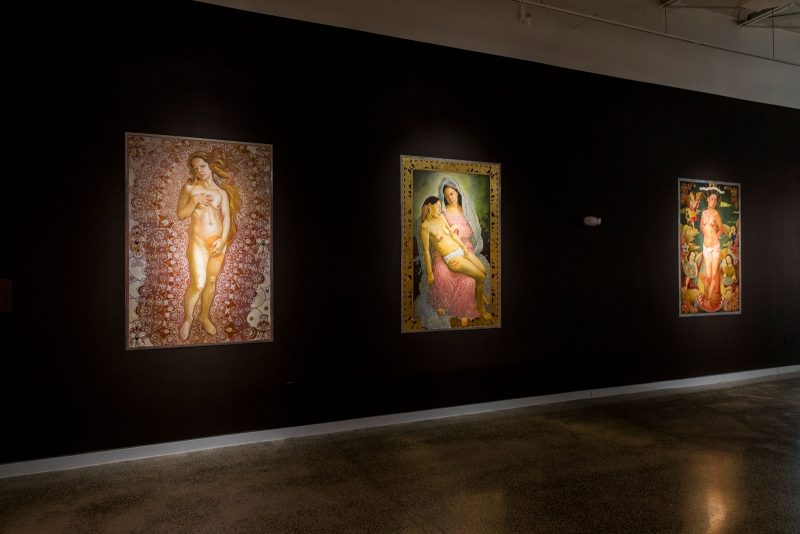When I walk into the gallery at Taller Puertorriqueño, Kukuli Velarde is hard at work, standing on a ladder, tracing out intricate shapes in black marker against a white mural surface in the center of the space. Her face gazes out at me, five, ten, fifteen-fold, from the rich, lustrous paintings on the gallery walls (not to mention the light rendering of that impenetrable, resolute gaze in red pencil in her new mural work). Her show, The Complicit Eye, presents Velarde in all manner of guises: naughty pin-up girl, martyred saint tied to a post, grieving Virgin and Pietà figure together in one composition, pregnant and proud with swollen belly, beheaded by a smug-faced angel. In The Complicit Eye, Velarde paints herself in these female archetypal forms, confronting the viewer with their own preconceived notions of what it means to be a woman in a patriarchal society, to be flattened and reduced to a single consumable image. Drawing upon Western art history, popular culture, and Inca and Pre-Columbian motifs from her native Peru, she simultaneously calls attention to histories of colonialism and racism.

An ideal mother
The in-progress* mural, called “Vitruviana and Vitruvianita,” is a centerpiece of the exhibition, specifically meant to facilitate conversation between Velarde and the audience. One of the mural panels clearly depicts Velarde herself, her body drawn amidst a swirl of sinuous, chaotic forms, while the adjacent panel on the right depicts her young daughter. Both Velarde and her daughter’s faces are lightly rendered, made all the more jarring by the inclusion of cut-out photographs of their eyes. Velarde explains that the pose she’s drawn herself in is in homage to Leonardo da Vinci’s “Vitruvian Man” drawing, where the ideal male figure is inscribed in a circle and a square. Yet while Velarde’s body is posed roughly similarly to that of Leonardo’s man, arms extended at ninety degrees and the legs held together, the order and geometric rationality of “Man” and man’s world becomes the chaotic discord of womanhood. Velarde’s body is held together in the torso area by the thinnest of strings, while one of her legs is capped with a bird-like claw where a foot should be.
Velarde tells me that girls are said to mature faster than boys do, and she believes they have to do so in order to deal with the reality of living in patriarchy—of dealing with the terror of sexism, machismo, the specter of male violence against women. The graceful waves and shapes that extend from Velarde’s half of the composition to the panel containing her daughter symbolize Velarde’s stated desire to protect her young daughter from the horrors of growing up. Even as a work in progress, “Vitruviana and Vitruvianita” depicts the fantastical yet logical extension of this protective instinct: in order to survive in an irrational world, women must mold themselves into something strong, something unexpected (like a claw on the end of the human leg), to protect one another.
Flipping the script
The rest of Velarde’s works in The Complicit Eye offer similar critiques of female roles in a male-dominated world. “Leda” remixes Velarde’s unforgettable face into the long-lost Michelangelo painting of “Leda and the Swan,” today only known through reproductions. Yet as the swan slithers between Velarde’s legs, she’s ready to fight back against this assault by the god Zeus. In a striking shift from the original composition, one hand clamps around the swan’s beak, while the other grips a knife, unwilling to back down or surrender.
“Hispanic Ready Made,” one of the more sardonic works in the show, expands thematically into a critique of stereotypes of Latina women, as well as Western ignorance and homogenization of Latinx culture. Against a backdrop of floral wallpaper, Velarde has painted her head onto a body posed in a “boobs and butt pose” (infamous in comic books), where the spine is twisted to show the viewer both cleavage and rear end. But the genius of “Hispanic Ready Made” comes from the way Velarde has painted removable arms, facial expressions, accessories, and outfits, as if her body is one of those paper dolls with interchangeable clothing. A Carmen Miranda fruit hat, a mariachi sombrero, maracas, a cantaloupe bra, a smiling expression—it’s a mix and match of the coarsest stereotypes of Latinx identity. And Velarde goes a step further: the different pieces can be moved and swapped, and “Hispanic Ready Made” seems to invite the viewer to do so. Yet, as Velarde tells me, only she is allowed to change the components of the image. You want to fit her into your anachronistic box? Well, you’re not allowed to. Only Velarde can manipulate her own image.

Many sources, many styles
The technical aspects of Velarde’s craft are brilliant. She has a remarkable facility for rendering flesh, but also shows skill in imitating a variety of styles. In the work “Superuvian,” which takes the style of a comic book cover about gentrification, she mimics the flatter colors and punchy dialogue bubbles of comic book art, while “Pinup Wanna Be” perfectly imitates the breezy, almost Mannerist poses of classic pin-up girls. In “Nakaq Archangel,” Velarde combines both her typical naturalistic handling of oil paint with a purposefully stylized image of an angel, who holds her severed head in one hand and a sword in the other. Here Velarde’s own expression is particularly haunting and unrelenting, while the placid angel is rendered as white-skinned, his clothing reminiscent of Spanish Baroque garb. The stony gaze of Velarde’s head conjures the myth of Perseus and Medusa, in which the hero is tasked by the gods with beheading his enemy. According to the accompanying text, Nakaq was a god-like figure who committed mercy killings of those who begged it for help. Velarde has cast Nakaq as a colonial avatar of the Catholic Church, casually rendering violence against colonized peoples like Velarde’s own Peruvian ancestors.

Naked and unashamed
“Venusina,” another work that draws upon art-historical references, depicts Velarde in the pose of Botticelli’s Birth of Venus, skin and hair lightened to better suit colonial Western tastes. She’s blonder, thinner, whiter than the real Velarde, and the expression of absolute disgust on Velarde’s painted face hints at barely-concealed rage, as if the painting itself hates what it has to be. On the adjacent wall is Velarde’s expression of triumph and self-confidence, titled Daddy Likee?, where the fifty-five year-old (she told me her age) Velarde is posed sprawling, naked, unashamed of her body. In a sense, Daddy Likee? is the culmination of the various guises portrayed in The Complicit Eye; it combines designs from Inca textiles, writing in Spanish and English, and incorporates the versions of herself from other paintings in the show in a frieze, operating as a meta-reference to the entire collection of works on display. In the center of it all is Velarde, without persona or disguise, not taking the role of anyone except that of herself.
[For more on Kukuli Velarde, see this post by Jennifer Zarro, with written commentary on the artist that gives context to her Artblog Radio interview, also in the same post.]
The Complicit Eye is on view November 16, 2018 – April 30, 2019 at Taller Puertorriqueño, 2600 North 5th Street, Philadelphia, PA 19133; Gallery Hours: 10- 6, Monday – Saturday; Phone: (215) 426-3311.
*During the first 10 days of the exhibition, Velarde is drawing a freehand mural in marker on the wall of the gallery while in conversation with visiting members of the community.






